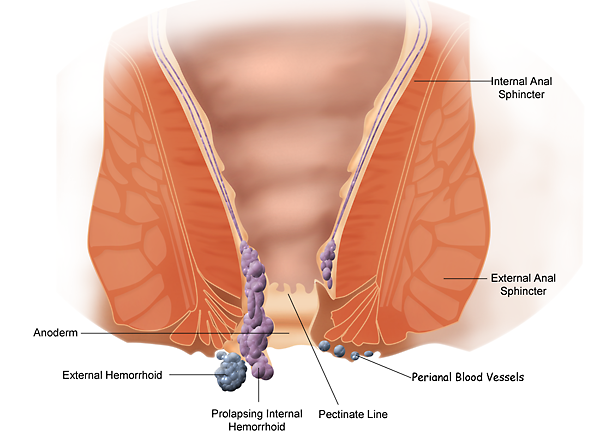Hemorrhoids Basics
What are Hemorrhoids?
When the small blood vessels near the surface of the lining of the lower rectum and anus become swollen and inflamed they are known as hemorrhoids (US English, or haemorrhoids in British English). They are also commonly referred to as piles.
The rectum is the final straight, approximately vertical, portion of the large intestine. The rectum terminates at the anus, the opening to the outside world that allows solid waste matter (feces or stools) to be excreted. The anus is surrounded by sphincter muscles that control its opening and closure and assist in the expulsion of feces during defecation.

The Anus, with Hemorrhoids
Image from Wikipedia, slightly modified and
republished under the terms of the GNU Free Documentation License.
Hemorrhoids can be classified as internal or external, depending on which side of the anal verge (pectinate line or anorectal junction – an anatomical dividing line between the upper and lower halves of the anal canal). In more severe cases, internal hemorrhoids can become so large that they are pushed outside of the anus during defecation, becoming prolapsed. These often either return inside the anus of their own accord, or can be manually pushed back inside. This leads to a commonly used grading scale of severity due to Banov:
- Grade I – Hemorrhoids do not prolapse.
- Grade II – Hemorrhoids prolapse during defecation, but then spontaneously reduce.
- Grade III – Hemorrhoids prolapse during defecation, but have to be manually reduced.
- Grade IV – Prolapsed hemorrhoids that cannot be manually reduced.
The anal sphincter muscles can sometimes cut off the blood supply to prolapsed hemorrhoids, a condition known as strangulated hemorrhoids. Hemorrhoids can also become thrombosed if the blood vessel ruptures and a clot develops, resulting in a solid lump.
Internal hemorrhoids are generally not painful because this part of the rectum does not contain pain receptors, although if they prolapse they can then become irritated and therefore painful. The most common symptom is bleeding during or just after defecation: bright red fresh blood is visible on the feces, in the toilet pan and on the toilet paper. External hemorrhoids, however, are more likely to be painful, and irritation of the surrounding skin often causes itching.
Hemorrhoids are generally not a serious condition, and are rarely dangerous or life threatening, unless they occur in conjunction with other conditions (for example, bleeding hemorrhoids could be a serious problem for those with hemophilia, the reduced ability for blood clotting). Indeed, many people do not know that they have them until they become severe enough to bleed, since the internal variety are generally not painful. The symptoms also often disappear within a few days.
The incidence of hemorrhoids is, however, very common, at least in developed countries: about half of all men and women will have had them by the time they reach 50. They also become increasingly common with age. Pregnant women are also prone to developing hemorrhoids, although in these cases the condition is generally temporary, disappearing once the pregnancy is over. The condition is much rarer, however, in developing countries and almost unknown in tribal communities.
In This Section:
Page 1 of 4
- Next Page >
- Last Page >>


